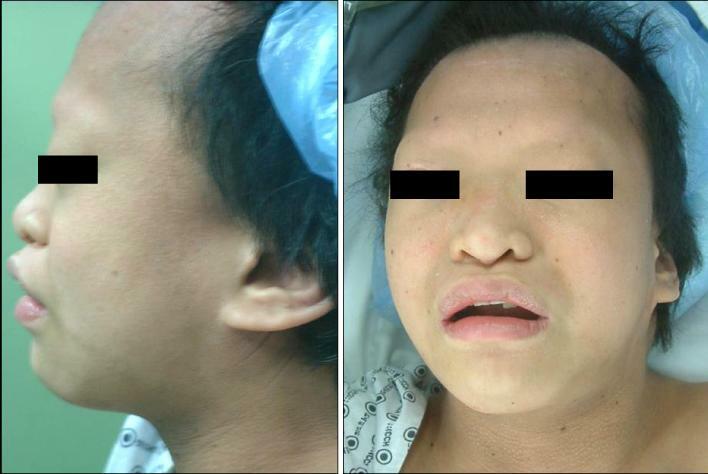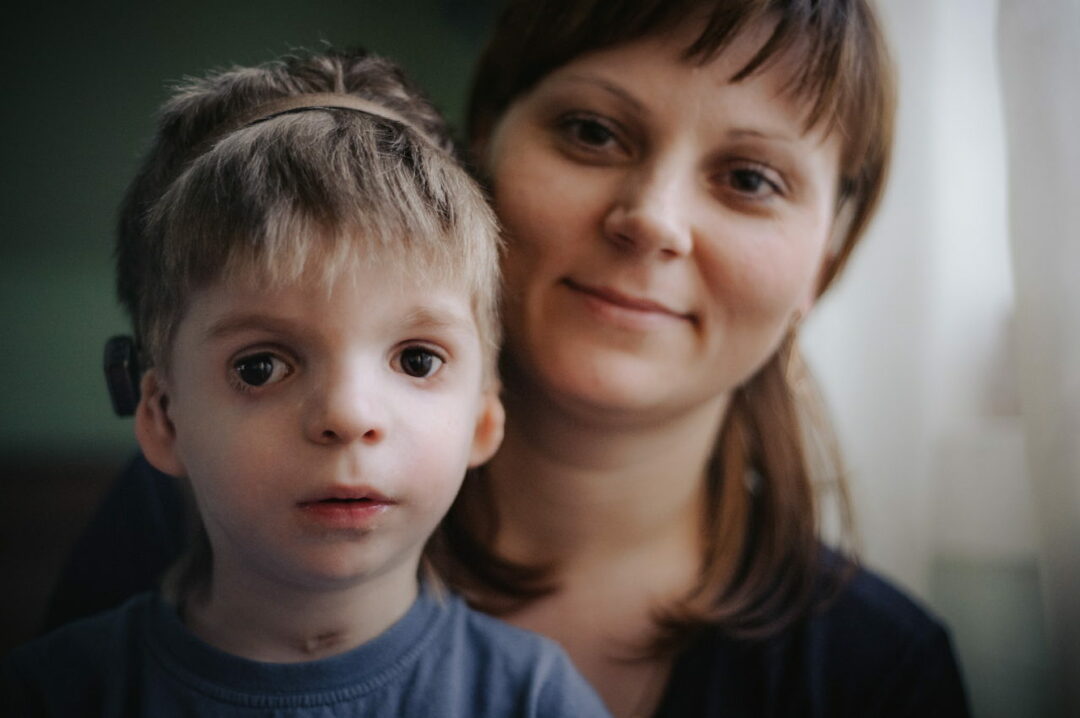Dubovitsa syndrome: causes, symptoms, treatment, prognosis
Content
- What is Dubovitz Syndrome?
- Signs and symptoms
- Causes
- Affected populations
- Related disorders
- Diagnostics
- Treatment
- Forecast
What is Dubovitz Syndrome?
Dubovitsa syndrome is a rare genetic disease that has been diagnosed in only 150-200 people in the world. The disease can be diagnosed before and after birth based on specific symptoms. Symptoms include small stature (may occur during pregnancy), slow growth, small head (microcephaly), mental retardation, eczema, frequent infections, and unusual and specific features faces. Facial features include a narrow or triangular face, a high or sloping forehead, undeveloped bones around the eyes, ptosis, blepharophimosis, large ears, sparse hair, and eyebrows.
Other symptoms sometimes seen with the condition include unusual fingers and toes, skeletal differences, and malformed testicles and penis or vagina. People can also have problems with the digestive system, heart, nerves, and muscles. Sometimes people with Dubovitsa syndrome develop cancer, especially of the blood (leukemia) or lymph nodes (lymphoma). The exact risk of developing cancer is unknown. People with the condition may have behavioral problems such as being aggressive, having trouble sleeping or eating,
ADHD (attention deficit / hyperactivity disorder).Some of the structural symptoms of Dubovitz syndrome can be treated with surgery. Special medications can help treat certain behavioral problems and eczema. Growth hormone can help accelerate growth. Speech therapies and additional educational assistance can help treat mental retardation. Physical therapy and occupational therapy can also help a child learn self-help skills (self-reliance). The type of cancer treatment depends on what type of cancer is being observed.
Dubovits Syndrome was first discovered by Dr. Viktor Dubovits in 1965. Since then, no common genetic cause has been identified. Scientists have discovered many different genetic abnormalities that can cause Dubovitz syndrome. For this reason, some researchers wonder if this is a true genetic disorder or if it is just a group of symptoms that often appear together. However, most researchers still believe that this is a genetic disorder.
Signs and symptoms

While there are some differences in the types and severity of symptoms a sufferer may have, people with Dubovitz syndrome have a few things in common.
Almost all patients grow slowly. This can be seen before birth on an ultrasound scan. It can also be seen after birth. People usually have a small head (microcephaly), with a small jaw (micrognathia). Patients also have mild to moderate mental retardation. People with Dubovitsa syndrome are prone to allergies and infections easily. About half of patients have eczema (rough, red, itchy areas of the skin). photo below)).

The best way to identify Dubovitz syndrome is through facial features. People have a narrow or triangular face with a high or sloping forehead. The bones around the eyes are incompletely formed (hypoplastic supraorbital ridges), and the eyes are far apart (hypertelorism). Patients usually have drooping of the eyelids (ptosis), which makes the eyes look wide and narrow (blepharophimosis). The patient's ears are large, not fully formed and set close to the head.
Affected people also have sparse hair and eyebrows. The roof of the mouth of sufferers tends to be higher than normal (arched palate) and they may suffer from cleft lip/неба. Hearing problems were not reported, but vision problems such as farsightedness and cataract (clouding of the lens of the eye).
People with Dubovitsa syndrome may have problems with the nervous system, which makes their muscles weak and makes it difficult to move correctly (muscle hypotonia). There may also be skeletal problems, such as lateral deviation of the fingers (clinodactyly). Sometimes there is partial or complete fusion of the fingers (syndactyly). Other skeletal problems include scoliosis, poorly formed or missing ribs. Sometimes parts of the spine (vertebra) merge together, making movement difficult.
Many people with Dubovitsa syndrome have problems with the immune system, allergies and infectious diseases. Immune system problems are caused by anemicwhen there are not enough white (and red) blood cells in your blood to fight infections. Some people have poorly formed reproductive organs (genitals), such as the penis, testicles, vagina, and clitoris. Sometimes men do not descend testicles (cryptorchidism), and the opening of the urethra (urethra) may open under the penis rather than at the tip (hypospadias). People with the condition may also have a poorly formed digestive system, lungs, and heart. The patient's voice tends to be high-pitched and hoarse.
It is impossible to predict the level of mental retardation; however, for some it is normal. Serious mental retardation is rare in this condition. Children with Dubovitsa syndrome may acquire self-care skills (dressing, eating, and going to the toilet) later than other children of the same age. Children may have speech delays. They may find it difficult to go to school and may need to stay in the same class several times. Children may have behavior problems such as hyperactivity, inability to concentrate, and hysteria. Many children are diagnosed with ADHD. Children may also have trouble sleeping and eating.
Dubovitsa syndrome increases the risk of specific cancers. The exact risk of developing cancer is unknown. Blood cancers are common, such as leukemia, and cancer of the lymph nodes (lymphomas). Patients may also develop nerve cell cancer (neuroblastoma), muscle cancer (myosarcoma), and sarcoma (soft tissue / bone cancer).
Causes
The cause of Dubovitsa syndrome is not known. Some affected people have changes (mutations) in their genes NSUN4 and LIG4, while others had minor additions or deletions of DNA (microduplications / microdeletions).
Research suggests that this condition can be passed across the family in an autosomal recessive manner. Everyone inherits two copies of genes, one from the mother and the other from the father. Sometimes genes have mutations that prevent them from functioning properly. If both copies of a particular gene do not function properly, the person will have a certain autosomal recessive genetic condition. If a person has one normal gene and one gene that is not working, the person will be an asymptomatic carrier of the disease. The probability that two carrier parents will have a sick child is 25% with each pregnancy. The probability of having a carrier baby is 50% with every pregnancy. The probability for a child to receive normal genes from both parents is 25%. The risk is the same for men and women.
Affected populations
Men and women have an equal chance of developing Dubovitz syndrome. The disease can occur in people of all nationalities and races. There are between 150 and 200 cases reported in scientific papers, but researchers believe there are more people with Dubovitz syndrome who have not been diagnosed.
Related disorders
Dubovitz syndrome is often confused with other genetic conditions due to similar symptoms. These other genetic conditions include Bloom's syndrome, Fanconi's anemia, and fetal alcoholic (fetal) syndrome. People with Bloom Syndrome also have short stature, slow growth, often contract infections and are more likely to have cancer. The main difference between Bloom Syndrome and Dubovitz Syndrome is that the facial features in Dubovitz Syndrome are not similar to those in Bloom Syndrome. In addition, people with Bloom syndrome develop red and purple patches on their skin caused by blood vessels.
Fanconi anemia Is a genetic form of aplastic anemia. Aplastic anemia is a condition where the bone marrow does not produce enough red and white blood cells. This is a rare symptom of Dubovitsa syndrome. The way to distinguish Fanconi's anemia from Dubovitz's syndrome is through facial features.
Fetal alcohol syndrome occurs as a result of the mother's consumption of large amounts of alcohol during pregnancy. Their children are born with short stature and small heads. Children also experience growth difficulties and intellectual retardation. However, fetal alcohol syndrome has its own set of facial features that differ from those of Dubovitz syndrome. In particular, in people with alcohol syndrome, the fetus has a thin upper lip and no folds of skin under the nose.
Diagnostics
Researchers debate whether Dubovitz syndrome is a true genetic condition, as no specific gene mutations or genetic differences that cause the condition have been found. Some scientists believe that Dubovitz syndrome is a group of symptoms that often occur together. This makes diagnosing the syndrome somewhat difficult, as geneticists cannot order a definitive genetic test. They can only diagnose the disease based on the symptoms the sufferers are experiencing, and people with the disease show different types of symptoms. The main symptoms that genetics are looking for are short-sluggish growth, small head, specific facial features, intellectual disabilities, and eczema.
- Clinical analyzes and examination.
People with Dubovitsa syndrome should have frequent medical check-ups based on their symptoms. Because vision problems are common, patients should see an ophthalmologist once a year. Children should also be examined by an endocrinologist to monitor their growth as they get older. It is also necessary to have frequent blood tests for anemia or potential cancer. Patients may also need to see a dermatologist to monitor eczema.
Treatment
Treatment for Dubovitsa syndrome depends on the symptoms that the patient has. Eczema is difficult to treat because half of people use corticosteroid cream (which is often used to treat eczema) does not help. A dermatologist can help determine what is best for treating eczema. Glasses or contact lenses can help with vision problems. A cataract (clouding of the lens) in the eye must be surgically removed. Surgery can also correct many skeletal problems, especially fingers, hands, and feet. Some facial features can also be corrected with surgery such as cleft palate and ptosis. For some sick children, taking growth hormone can help them grow faster. If cancer is present, the type of treatment depends on the type of cancer the person has.
Although there is no treatment for mental disorders, there are several measures that can help. Children feel better when they have frequent speech therapists and special help or tutoring in school subjects. Occupational therapy or physical therapy can also help teach children self-help skills. Behavioral problems such as ADHD, food refusal, or tantrums can be treated with medication or behavioral therapy.
Forecast
Relative prognosis for individuals with this syndrome — good, however, provided that the patient regularly visits his attending physician. Some people with this syndrome can lead a fairly normal life, even with minor mental retardation.


